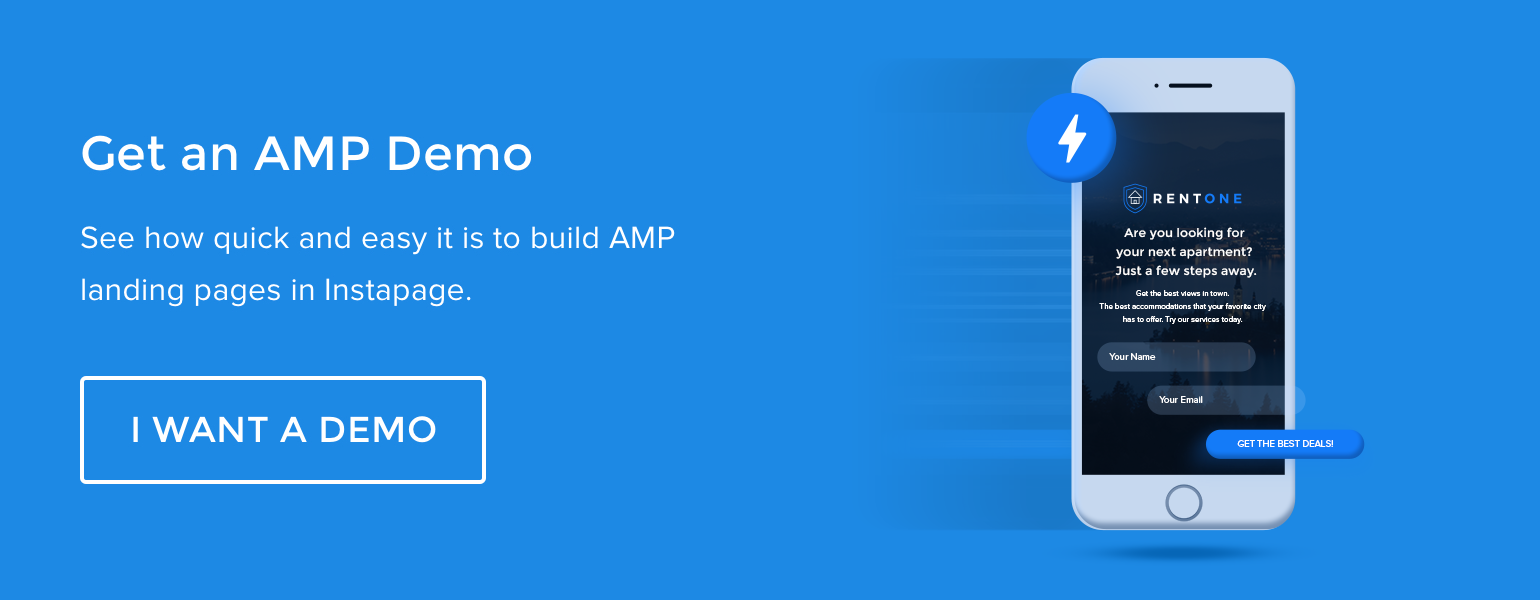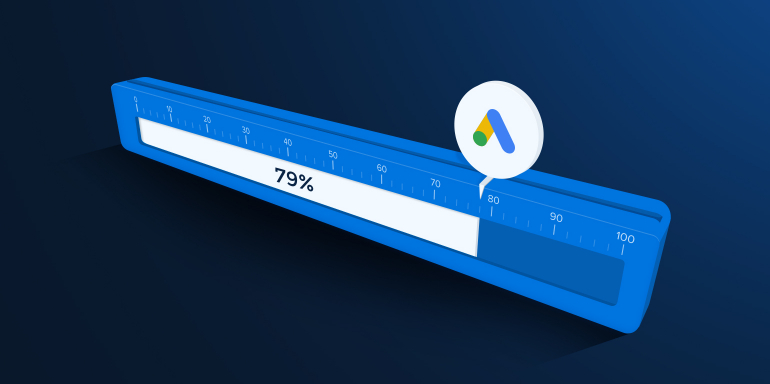For digital advertisers using Google Ads (formerly AdWords), there is a new feature that will help you get the most out of your ad campaigns — Google Ads optimization score.
Google recently sent out an email informing users about the new feature:
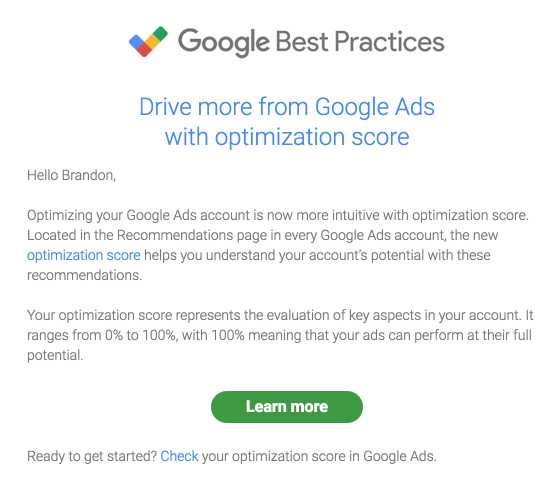
Don’t worry if you didn’t receive the email or are unsure how Google’s optimization score works. In this article, you’ll learn what the new feature is, how it’s calculated, and how you can improve your score.
What is Google’s optimization score?
Google’s ad optimization score is a percentage amount that indicates how well your campaigns are optimized based on a number of factors such as bid amounts, keyword types, bid strategy, etc. The feature was first announced in July 2018 and is now viewable for all users in the Recommendations tab in your Google Ads account.
This is how the score looks like in your account (the percentage will vary, of course):
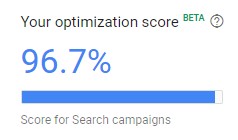
While the feature is in beta, users can still use their optimization score to evaluate the effectiveness of their ad campaigns. It should be noted that, this feature is only available for Google Ad users that have active Search campaigns. It is not available in AdWords Express or used by your Quality Score or Ad Rank.
How is it calculated?
Google’s optimization score is calculated in real-time on a scale of 0 to 100% based on your campaign’s performance and your implementation of Google’s recommendations.
When calculating your score, Google considers your campaign’s:
- Bids & Budgets
- Ads & Extensions
- Keywords & Targeting
- Repairs
It also factors in variables such as:
- Statistics, settings, and the status of your account and campaigns
- Relevant impact of available recommendations
- Recent recommendations history
- Trends in the ads ecosystem
If your score does not equal 100%, Google provides recommendations and indicates how your score will be affected should you choose to apply it. A recommendation that would have a more meaningful impact on your campaign’s performance is given more weight on your overall score. This effect is represented by a “score uplift” value from <0.1% to 100%, representing the estimated impact on overall campaign performance.
How to improve your optimization score
Recommendations are designed to help you optimize your budget by improving bids, keywords, and ads. The end goal is to increase overall performance and efficiency of your ad campaigns.
To improve your score, you must either accept or decline Google’s recommendations. Your score will be updated no matter which option you choose. However, if you decide to dismiss the recommendations, they are represented in gray color when you hover over your score. You can view your dismissed recommendations at any time by clicking the “Dismissed” button:
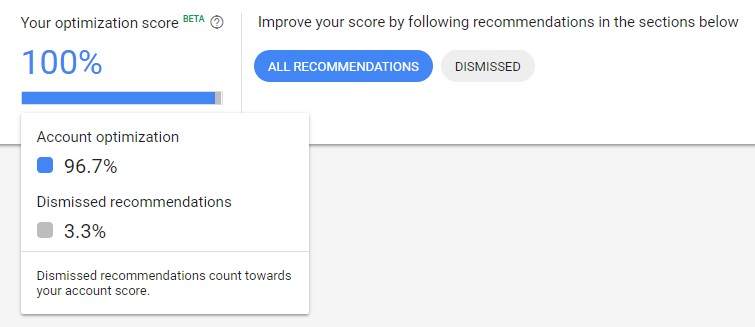
Note: It’s important to know that your score could sum up to more than 100%. This is because some recommendations will invalidate other recommendations when accepted.
How to check your score and accept or decline recommendations
Once you log in to your Google Ads account, click Recommendations from the left-head navigation menu. This will bring you to your Recommendations page, where at the top, you will see your optimization score:
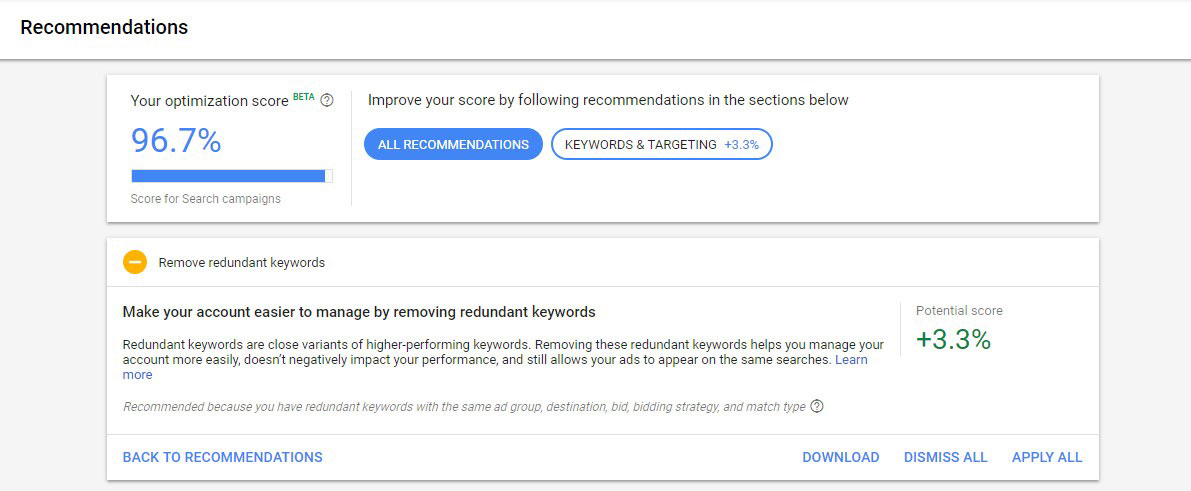
Below that, you will see any recommendations that Google has suggested for your account.
You can view these recommendations at a glance or click “Learn more” to find out what impact each one might have and why it has been suggested for your account. If you have many recommendations, you can filter by specific category.
If you agree with Google’s recommendations, you can click “Apply” to apply that specific one or click “Apply All” to apply all of them at once. You can also dismiss the recommendation by clicking “Dismiss.”
Each recommendation will show a score uplift percentage under the label, “Potential Score” like this:
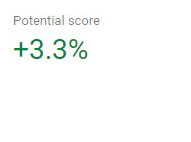
If this recommendation was applied, your optimization score would increase by 3.3%.
Recommendation examples
Recommendations are custom for each account. However, here are a few examples that you might see:
- Remove redundant keywords: Make your account easier to manage by removing redundant keywords:
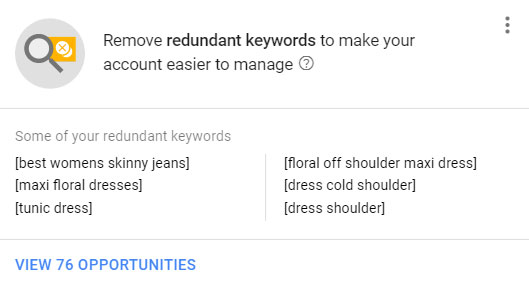
- Promote post-click landing pages missing from your ads: post-click landing pages relevant to potential customers are missing from your ads
- Bid more efficiently with Enhanced CPC: Automatically optimize your bids at auction time for searches more likely to lead to conversions
- Bid more efficiently with Target CPA: Get more conversions at a lower or similar CPA with a fully automated bid strategy

Target CPA and Enhanced CPC (ECPC) are both automated bid strategies that use machine learning to increase conversions. To learn more about automated bidding, read this article.
- Lower your bids: Lower your bids to get more clicks for the same or lower cost.
- Raise your budgets: Keep your ads running on your busiest days by fixing your limited budget.
- Add new keywords: Show your ads on more searches relevant to your business.
- Improve your mobile site: Avoid losing customers on mobile devices by improving your mobile site.
This list is only a snapshot of the potential recommendations. For a full list, please refer to Google’s help guide.
Improve your campaign performance with AMP post-click landing pages
While Google continues to make its ad platform more user-friendly through visual representations of performance (i.e. optimization score), maximizing your ads performance requires a hands-on approach in key areas of a successful ad campaign.
One of those key areas is the ad’s post-click landing page. With mobile ads becoming more popular, a focus on mobile optimized pages is a priority for advertisers.
Problem areas such as speed, design, and user experience hurt poorly built mobile post-click landing pages. The best way to avoid these problems is to use a post-click landing page solution that prioritizes the mobile experience, such as the Instapage AMP builder.
To learn more about AMP and see it in action, request a free demo today.
